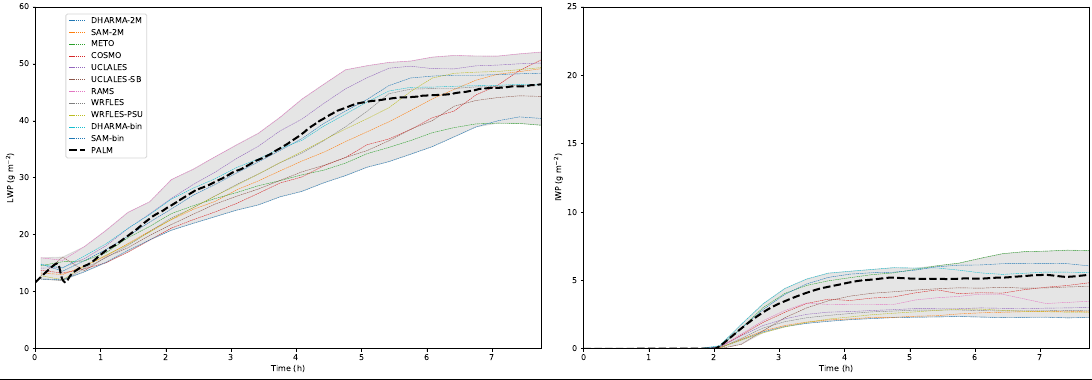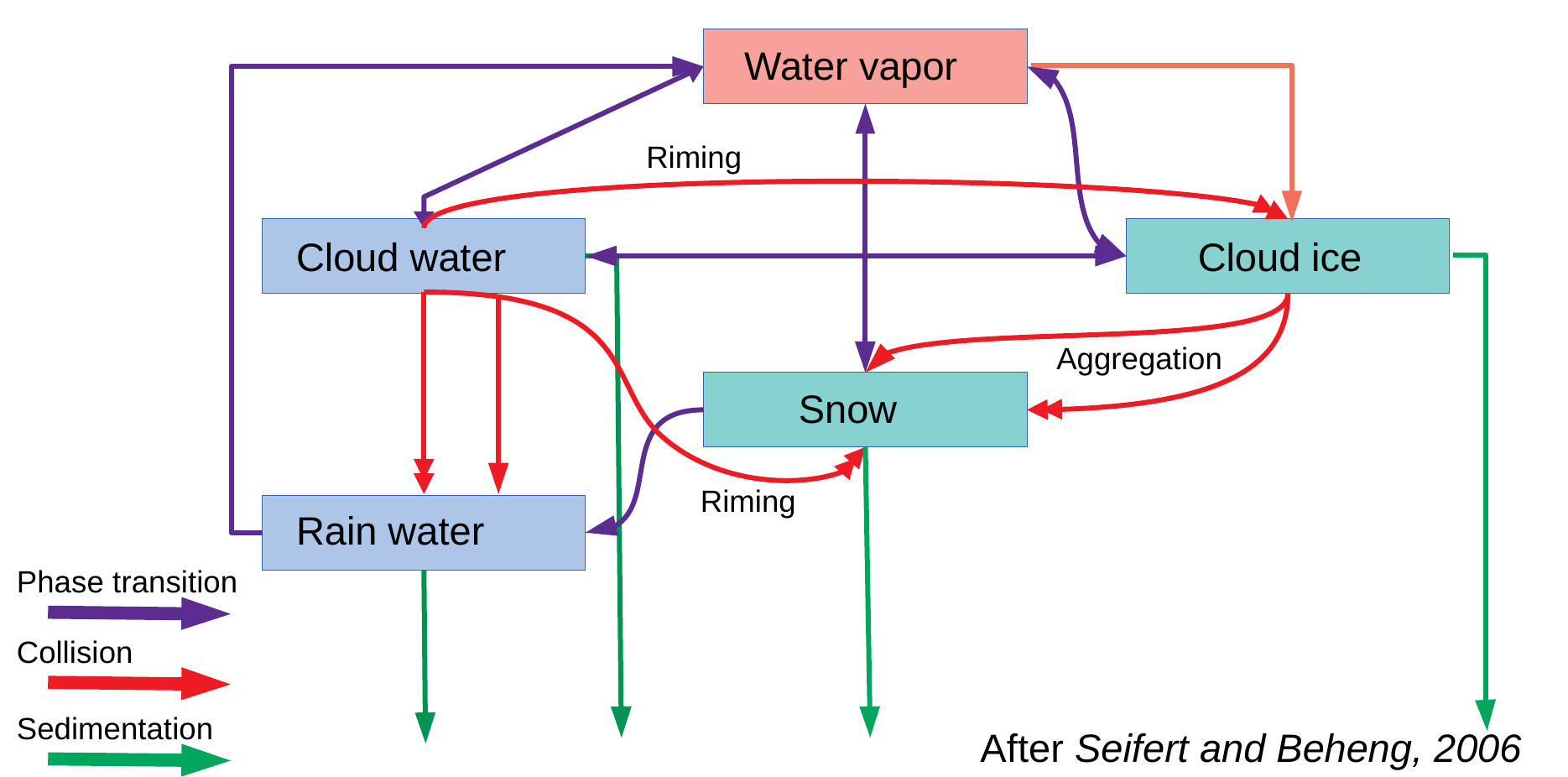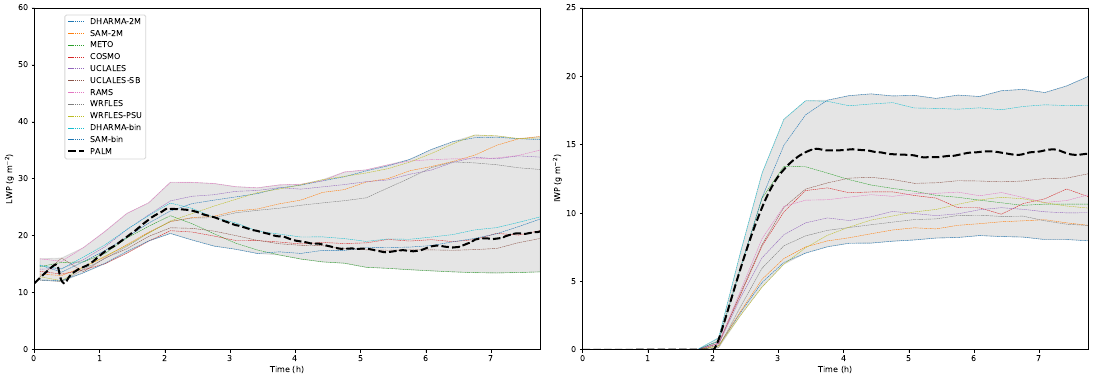WP-P1: Frozen water in the atmosphere and on the ground
Goals of the project:
The currently available cloud microphysics parametrisation in PALM-4U, which only considers the liquid phase of cloud waser, will be extended by an ice phase description according to Seifert and Beheng (2006). Therefore, it already provides a possibility to couple it with cloud and precipitation data from COSMO as here the same parametrisations are used. Thus cloud physical information and variables can be transferred directly from COSMO into PALM-4U. The implementation includes the consideration of growing ice crystals, snow flakes, graupel, and their interaction with liquid water as well as the deposition onto surfaces. After the implementation has occured, the new parametrisation will be tested and validated for known and well-documented standard cases (Morrison et al. 2011).
A snow cover parametrisation will be implemented in PALM-4U according to the ECMWF scheme (Dutra et al. 2009, Dutra et al. 2010) in order to consider the snow cover on surfaces and the resulting changes in the energy balance. Here, the snow cover will be represented as an additional layer in the surface model (or wall model) for which an individual prognostic equation is responsible for the snow temperature. The parametrisation will be in accordance to the HTESSEL scheme in the ECMWF-IFS model that is also the basis for the land surface model within PALM-4U. The schematic includes an adapted energy balance solver for the snow temperature considering the properties of snow covers (i.e. snow height, snow density), albedo (depending on the age of the snow cover), mass fluxes due to melting and sublimation processes, internal phase changes, and the energy exchange between snow cover and atmosphere as well as with the underlying ground. Mass fluxes via snow fall and rain are explicitily considered. In addition a parametrisation for freezing/melting of water surfaces (i.e. lakes) will be added to PALM-4U.
After technical tests the new snow cover schematic will be applied to simulations with PALM-4U based on the input data for the Winter-IOP1 in Berlin. In the first funding phase evaluation runs for this IOP have been conducted without consideration of a snow cover, even though Berlin showed in parts a closed snow cover. As the exact distribution of this snow cover is unknown, different snow covers will be imprinted synthetically during several simulation and the evaluation runs will be repeated for these different configurations (in close coordination with WP-S3). The results are expected to show the type of effect a snow cover can have on the urban boundary layer and how far the evaluation simulations during the first funding phase were affected. Because of the simulation area also including rural surroundings (Brandenburg) differences between urban and rural snow cover and their effects on city-countryside-effects can be studied. Here, another simulation run is planned where the snow cover in present solely in the surrounding while the city will remain without snow. The simulation results should show in how far the urban heat island with snow cover contributes to re-coupling effects such as a city-countryside-circulation.
Tasks of the project:
WP-P1.1: Implementation of ice clouds, snow fall and graupel
WP-P1.2: Implementation of snow and ice in the land surface model
WP-P1.3: Evaluation for the winter IOP1 in Berlin
Project structure:
This work package will be conducted at the LUH.
Deliverables:
DL1 (month 12): Ice clouds and precipitation are available in PALM-4U
DL2 (month 27): snow and ice parametrisation schematics are implemented and available
DL3 (month 36): Case study for Berlin was conducted and evaluated with measurement data.
Progress so far:
The alread in PALM-4U implemented 2-moment cloud physic scheme following Seifert and Beheng (2006) was extended with the cloud ice species during the previous project runtime and now contains prognostical parameters of ice crystal number concentration and ice crystal mixing ratio. In addition the microphysical processes of nucleation, deposit growth of ice crytals, and sedimentation of cloud ice are considered. For the validation of the implemented processes simulations based on an idealised case study (Ovchinnikov et al., 2014) of an Arctic mixed phase cloud (figures 1 & 2) have been conducted. The figures show time series of the liquid water path (LWP) and the ice water path (IWP) for PALM-4U as well as additional LES models with similar microphysics parametrisations for simulations of different ice seed numbers (fig.1: 1000 L-1, fig.2: 4000 L-1). In general, a good agreement with other models can be observed.

Figure 1: using 1000 L-1 ice seeds
Figure 2: using 4000 L-1 ice seeds
During the project duration the cloud physics will be extended by the snow species where in particular collision processes have to be taken into account (see fig. 3).

Figure 3: overview of cloud physics to be implemented in PALM-4U
References:
Dutra, E., Balsamo, G., Viterbo, P., Miranda, P. M., Beljaars, A., Schär, C., Elder, K., 2010, An improved snow scheme for the ECMWF land surface model: Description and offline validation. Journal of Hydrometeorology, 11(4), 899-916. https://doi.org/10.1175/2010JHM1249.1.
Dutra, E., Balsamo, G., Viterbo, P., Miranda, P., Beljaars, A., Elder, K., 2009, New snow scheme in htessel: description and offline validation, ECMWF.
Morrison, H., et al.,2011, Intercomparison of cloud model simulations of Arctic mixed‐phase boundary layer clouds observed during SHEBA/FIRE‐ACE, J. Adv. Model. Earth Syst., 3, M05001, https:/doi.org/10.1029/2011MS000066.
Seifert, A., Beheng, K. A., 2006, two-moment cloud microphysics parameterization for mixed-phase clouds, Part 1: Model description, Meteorol. Atmos. Phys. 92, 45–66, https://doi.org/10.1007/s00703-005-0112-4.
Ovchinnikov, M., et al., 2014, Intercomparison of large‐eddy simulations of Arctic mixed‐phase clouds: Importance of ice size distribution assumptions, J. Adv. Model. Earth Syst., 6, 223– 248, https://doi.org/10.1002/2013MS000282.
Contacts:
maronga[at]muk.uni-hannover.de
schwenkel[at]muk.uni-hannover.de
Attachments (3)
- WP-P1-figure1.png (64.0 KB) - added by hettrich 5 years ago.
- WP-P1-figure2.png (66.0 KB) - added by hettrich 5 years ago.
- WP-P1-figure3.png (107.2 KB) - added by hettrich 5 years ago.
Download all attachments as: .zip




